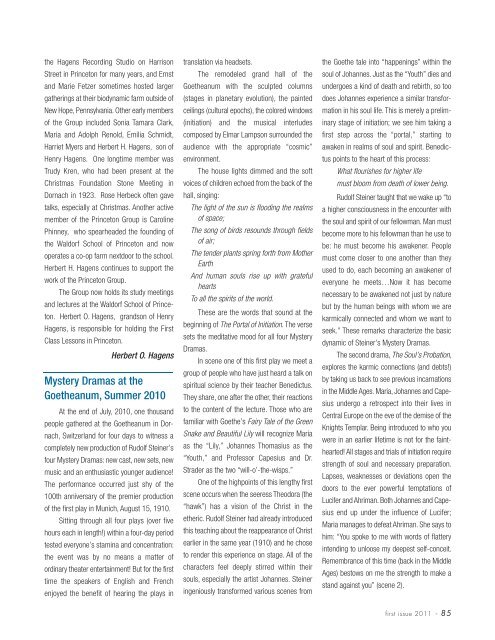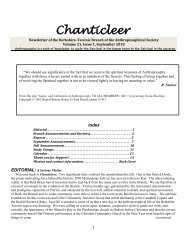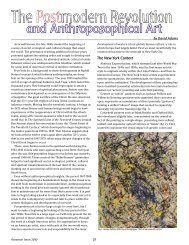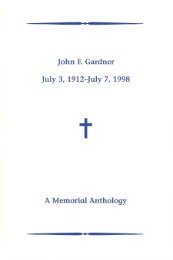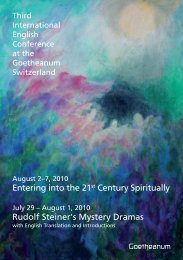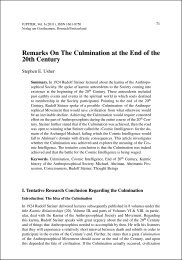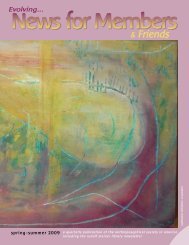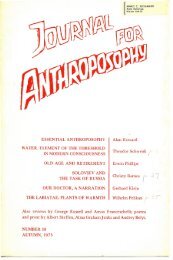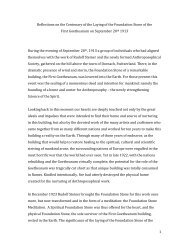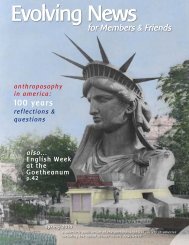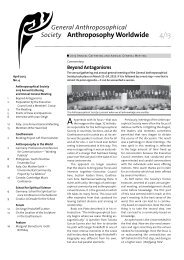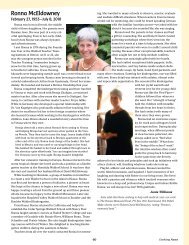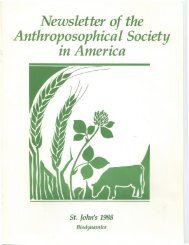Rudolf Steiner's Vision for the Future - Anthroposophical Society in ...
Rudolf Steiner's Vision for the Future - Anthroposophical Society in ...
Rudolf Steiner's Vision for the Future - Anthroposophical Society in ...
Create successful ePaper yourself
Turn your PDF publications into a flip-book with our unique Google optimized e-Paper software.
<strong>the</strong> Hagens Record<strong>in</strong>g Studio on Harrison<br />
Street <strong>in</strong> Pr<strong>in</strong>ceton <strong>for</strong> many years, and Ernst<br />
and Marie Fetzer sometimes hosted larger<br />
ga<strong>the</strong>r<strong>in</strong>gs at <strong>the</strong>ir biodynamic farm outside of<br />
New Hope, Pennsylvania. O<strong>the</strong>r early members<br />
of <strong>the</strong> Group <strong>in</strong>cluded Sonia Tamara Clark,<br />
Maria and Adolph Renold, Emilia Schmidt,<br />
Harriet Myers and Herbert H. Hagens, son of<br />
Henry Hagens. One longtime member was<br />
Trudy Kren, who had been present at <strong>the</strong><br />
Christmas Foundation Stone Meet<strong>in</strong>g <strong>in</strong><br />
Dornach <strong>in</strong> 1923. Rose Herbeck often gave<br />
talks, especially at Christmas. Ano<strong>the</strong>r active<br />
member of <strong>the</strong> Pr<strong>in</strong>ceton Group is Carol<strong>in</strong>e<br />
Ph<strong>in</strong>ney, who spearheaded <strong>the</strong> found<strong>in</strong>g of<br />
<strong>the</strong> Waldorf School of Pr<strong>in</strong>ceton and now<br />
operates a co-op farm nextdoor to <strong>the</strong> school.<br />
Herbert H. Hagens cont<strong>in</strong>ues to support <strong>the</strong><br />
work of <strong>the</strong> Pr<strong>in</strong>ceton Group.<br />
The Group now holds its study meet<strong>in</strong>gs<br />
and lectures at <strong>the</strong> Waldorf School of Pr<strong>in</strong>ceton.<br />
Herbert O. Hagens, grandson of Henry<br />
Hagens, is responsible <strong>for</strong> hold<strong>in</strong>g <strong>the</strong> First<br />
Class Lessons <strong>in</strong> Pr<strong>in</strong>ceton.<br />
Herbert O. Hagens<br />
Mystery Dramas at <strong>the</strong><br />
Goe<strong>the</strong>anum, Summer 2010<br />
At <strong>the</strong> end of July, 2010, one thousand<br />
people ga<strong>the</strong>red at <strong>the</strong> Goe<strong>the</strong>anum <strong>in</strong> Dornach,<br />
Switzerland <strong>for</strong> four days to witness a<br />
completely new production of <strong>Rudolf</strong> Ste<strong>in</strong>er’s<br />
four Mystery Dramas: new cast, new sets, new<br />
music and an enthusiastic younger audience!<br />
The per<strong>for</strong>mance occurred just shy of <strong>the</strong><br />
100th anniversary of <strong>the</strong> premier production<br />
of <strong>the</strong> first play <strong>in</strong> Munich, August 15, 1910.<br />
Sitt<strong>in</strong>g through all four plays (over five<br />
hours each <strong>in</strong> length!) with<strong>in</strong> a four-day period<br />
tested everyone’s stam<strong>in</strong>a and concentration:<br />
<strong>the</strong> event was by no means a matter of<br />
ord<strong>in</strong>ary <strong>the</strong>ater enterta<strong>in</strong>ment! But <strong>for</strong> <strong>the</strong> first<br />
time <strong>the</strong> speakers of English and French<br />
enjoyed <strong>the</strong> benefit of hear<strong>in</strong>g <strong>the</strong> plays <strong>in</strong><br />
translation via headsets.<br />
The remodeled grand hall of <strong>the</strong><br />
Goe<strong>the</strong>anum with <strong>the</strong> sculpted columns<br />
(stages <strong>in</strong> planetary evolution), <strong>the</strong> pa<strong>in</strong>ted<br />
ceil<strong>in</strong>gs (cultural epochs), <strong>the</strong> colored w<strong>in</strong>dows<br />
(<strong>in</strong>itiation) and <strong>the</strong> musical <strong>in</strong>terludes<br />
composed by Elmar Lampson surrounded <strong>the</strong><br />
audience with <strong>the</strong> appropriate “cosmic”<br />
environment.<br />
The house lights dimmed and <strong>the</strong> soft<br />
voices of children echoed from <strong>the</strong> back of <strong>the</strong><br />
hall, s<strong>in</strong>g<strong>in</strong>g:<br />
The light of <strong>the</strong> sun is flood<strong>in</strong>g <strong>the</strong> realms<br />
of space;<br />
The song of birds resounds through fields<br />
of air;<br />
The tender plants spr<strong>in</strong>g <strong>for</strong>th from Mo<strong>the</strong>r<br />
Earth<br />
And human souls rise up with grateful<br />
hearts<br />
To all <strong>the</strong> spirits of <strong>the</strong> world.<br />
These are <strong>the</strong> words that sound at <strong>the</strong><br />
beg<strong>in</strong>n<strong>in</strong>g of The Portal of Initiation. The verse<br />
sets <strong>the</strong> meditative mood <strong>for</strong> all four Mystery<br />
Dramas.<br />
In scene one of this first play we meet a<br />
group of people who have just heard a talk on<br />
spiritual science by <strong>the</strong>ir teacher Benedictus.<br />
They share, one after <strong>the</strong> o<strong>the</strong>r, <strong>the</strong>ir reactions<br />
to <strong>the</strong> content of <strong>the</strong> lecture. Those who are<br />
familiar with Goe<strong>the</strong>’s Fairy Tale of <strong>the</strong> Green<br />
Snake and Beautiful Lily will recognize Maria<br />
as <strong>the</strong> “Lily,” Johannes Thomasius as <strong>the</strong><br />
“Youth,” and Professor Capesius and Dr.<br />
Strader as <strong>the</strong> two “will-o’-<strong>the</strong>-wisps.”<br />
One of <strong>the</strong> highpo<strong>in</strong>ts of this lengthy first<br />
scene occurs when <strong>the</strong> seeress Theodora (<strong>the</strong><br />
“hawk”) has a vision of <strong>the</strong> Christ <strong>in</strong> <strong>the</strong><br />
e<strong>the</strong>ric. <strong>Rudolf</strong> Ste<strong>in</strong>er had already <strong>in</strong>troduced<br />
this teach<strong>in</strong>g about <strong>the</strong> reappearance of Christ<br />
earlier <strong>in</strong> <strong>the</strong> same year (1910) and he chose<br />
to render this experience on stage. All of <strong>the</strong><br />
characters feel deeply stirred with<strong>in</strong> <strong>the</strong>ir<br />
souls, especially <strong>the</strong> artist Johannes. Ste<strong>in</strong>er<br />
<strong>in</strong>geniously trans<strong>for</strong>med various scenes from<br />
<strong>the</strong> Goe<strong>the</strong> tale <strong>in</strong>to “happen<strong>in</strong>gs” with<strong>in</strong> <strong>the</strong><br />
soul of Johannes. Just as <strong>the</strong> “Youth” dies and<br />
undergoes a k<strong>in</strong>d of death and rebirth, so too<br />
does Johannes experience a similar trans<strong>for</strong>mation<br />
<strong>in</strong> his soul life. This is merely a prelim<strong>in</strong>ary<br />
stage of <strong>in</strong>itiation; we see him tak<strong>in</strong>g a<br />
first step across <strong>the</strong> “portal,” start<strong>in</strong>g to<br />
awaken <strong>in</strong> realms of soul and spirit. Benedictus<br />
po<strong>in</strong>ts to <strong>the</strong> heart of this process:<br />
What flourishes <strong>for</strong> higher life<br />
must bloom from death of lower be<strong>in</strong>g.<br />
<strong>Rudolf</strong> Ste<strong>in</strong>er taught that we wake up “to<br />
a higher consciousness <strong>in</strong> <strong>the</strong> encounter with<br />
<strong>the</strong> soul and spirit of our fellowman. Man must<br />
become more to his fellowman than he use to<br />
be: he must become his awakener. People<br />
must come closer to one ano<strong>the</strong>r than <strong>the</strong>y<br />
used to do, each becom<strong>in</strong>g an awakener of<br />
everyone he meets…Now it has become<br />
necessary to be awakened not just by nature<br />
but by <strong>the</strong> human be<strong>in</strong>gs with whom we are<br />
karmically connected and whom we want to<br />
seek.” These remarks characterize <strong>the</strong> basic<br />
dynamic of Ste<strong>in</strong>er’s Mystery Dramas.<br />
The second drama, The Soul’s Probation,<br />
explores <strong>the</strong> karmic connections (and debts!)<br />
by tak<strong>in</strong>g us back to see previous <strong>in</strong>carnations<br />
<strong>in</strong> <strong>the</strong> Middle Ages. Maria, Johannes and Capesius<br />
undergo a retrospect <strong>in</strong>to <strong>the</strong>ir lives <strong>in</strong><br />
Central Europe on <strong>the</strong> eve of <strong>the</strong> demise of <strong>the</strong><br />
Knights Templar. Be<strong>in</strong>g <strong>in</strong>troduced to who you<br />
were <strong>in</strong> an earlier lifetime is not <strong>for</strong> <strong>the</strong> fa<strong>in</strong><strong>the</strong>arted!<br />
All stages and trials of <strong>in</strong>itiation require<br />
strength of soul and necessary preparation.<br />
Lapses, weaknesses or deviations open <strong>the</strong><br />
doors to <strong>the</strong> ever powerful temptations of<br />
Lucifer and Ahriman. Both Johannes and Capesius<br />
end up under <strong>the</strong> <strong>in</strong>fluence of Lucifer;<br />
Maria manages to defeat Ahriman. She says to<br />
him: “You spoke to me with words of flattery<br />
<strong>in</strong>tend<strong>in</strong>g to unloose my deepest self-conceit.<br />
Remembrance of this time (back <strong>in</strong> <strong>the</strong> Middle<br />
Ages) bestows on me <strong>the</strong> strength to make a<br />
stand aga<strong>in</strong>st you” (scene 2).<br />
first issue 2011 • 85


